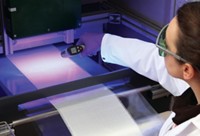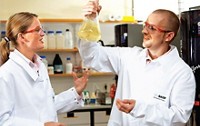Advertisement
Grab your lab coat. Let's get started
Welcome!
Welcome!
Create an account below to get 6 C&EN articles per month, receive newsletters and more - all free.
It seems this is your first time logging in online. Please enter the following information to continue.
As an ACS member you automatically get access to this site. All we need is few more details to create your reading experience.
Not you? Sign in with a different account.
Not you? Sign in with a different account.
ERROR 1
ERROR 1
ERROR 2
ERROR 2
ERROR 2
ERROR 2
ERROR 2
Password and Confirm password must match.
If you have an ACS member number, please enter it here so we can link this account to your membership. (optional)
ERROR 2
ACS values your privacy. By submitting your information, you are gaining access to C&EN and subscribing to our weekly newsletter. We use the information you provide to make your reading experience better, and we will never sell your data to third party members.
Business
Loosening the Purse Strings
by MARC S. REISCH, C&EN NORTHEAST NEWS BUREAU
February 2, 2004
| A version of this story appeared in
Volume 82, Issue 5

Chemical firms are allowing themselves once again to believe that an economic recovery is under way. Predictions in late 2000, 2001, and again in 2002 that a turnaround was just around the corner did not fool the financial guys. They were dealing with realities that still plague the industry: excess capacity, slack demand, and--over the past year--high natural gas prices.
But as signs gather that the economy is about to throw off its torpor, even the penny-pinchers are beginning to believe . A sampling of chemical firms' spending plans for 2004 shows that many are loosening the purse strings on investments in their own businesses . Mind you , tha doesn't mean planners have thrown all caution to the wind: At this juncture, it looks like capital spending will recover strongly in 2004 compared with the past few years, but that R&D budgets will hardly budge.
C&EN's annual survey of capital expenditures finds that a group of 18 chemical makers plans an almost heady 15.3% increase in their 2004 budgets to $5.5 billion compared with 2003. Given the year-to-year slide in investments in new plants and equipment for the previous five years, the 2004 pickup seems long overdue.
However, the 2004 increase planned for R&D is depressingly small. At $3.4 billion this year, the combined R&D budget of a group of 17 firms surveyed is up a mere 0.4% over last year. Factor in even a scintilla of inflation, and the minuscule uptick disappears.
And overall future-oriented spending is still severely depressed. The 17 firms that supplied both R&D and capital spending data for the past decade are budgeting $8.8 billion in 2004. Only in 2002 and 2003 did the group disburse less money over the past 10 years. In 1996, these same firms hit a 10-year spending high when they earmarked $10.8 billion for research and new equipment.
Take inflation into account, and it is a sorry picture indeed. The $8.8 billion in future-oriented spending set aside for this year is only $7.3 billion in 1994 dollars.
Over the past 10 years, the budget ax has fallen more heavily on capital spending than it has on R&D. Only 58% of funds went to capital improvement in 2003--a low for the decade. This year, capital spending will draw 62% of future-oriented funds. When industry prospects are a little brighter, capital projects tend to draw a higher proportion of future-oriented funds. More than 71% of funds went to such projects in 1996.

FUNDS DEVOTED to R&D--largely an investment in scientists' salaries--don't often fluctuate dramatically. With hope for a better future, most in the survey group maintained their commitment to R&D spending between 1999 and 2003, and as a result, 42% of future-oriented funds went to R&D in 2003--a high for the past decade. This year, 38% of funds are slated for R&D, compared with the decade low of 29% in 1996.

However, budgets are subject to change as managers react to business conditions. C&EN's survey--conducted in January--captures only the aggregate hopes and expectations of a select group of chemical firms at this moment in time.
For instance, companies surveyed in January 2003 planned to increase capital spending by 0.6% in 2003 (C&EN, Feb. 3, 2003, page 17). But companies surveyed again this year say they in fact tightened the purse strings as the economy continued to limp along in the first half of the year. Actual capital spending budgets slid 12.1% last year.
For R&D, the story was similar though not as dramatic. The group last year expected to cut R&D spending by 1% in 2003. Companies surveyed for this year's report say they actually cut it by 2.4%.
Of 18 companies surveyed for their 2004 capital spending plans, 13 expect to increase spending on new plants and equipment. Only two are planning cuts, and three anticipate that they will hold spending level with 2003. This compares with only five that increased spending in 2003, three that had no change, and 10 that cut spending.
C&EN predicts that the group's capital spending as a percent of sales will be 5.1%--just a bit above the low for the decade of 4.8% achieved last year. The estimate assumes an 8% increase in sales in 2004 as chemical firms seek to recover higher costs for energy and raw materials. The group achieved a 10-year high in 1998 when spending on capital projects peaked at 9.9% of sales.
Only seven of 17 companies expect to increase R&D spending in 2004, six plan no increase, and four will cut back. This compares with nine that increased expenditures in 2003, three that made no change, and five that cut their budgets.
C&EN estimates that in 2004, R&D as a percent of sales for the group will slip to a decade low of 3.2%--considerably below the decade high of 5.0% in 1994. Survey results put it at 3.4% last year.
Funds committed to R&D buy a lot less than they did a decade ago. Though actual dollars devoted to new product and process development for the group will be $3.4 billion, those funds represent only $2.8 billion on a constant-1994 dollar basis. The decade high of $3.6 billion was in 1994.
Two European firms responded to C&EN's request for information. DSM invested $504 million on capital projects in 2003 and plans to spend $630 million in 2004, including $189 million on the vitamins business acquired from Roche last year. DSM's R&D will increase from about $347 million to $410 million excluding vitamins in 2004. Belgian chemical and pharmaceutical group UCB spent $257 million on capital projects in 2004 and plans to spend $208 million this year. Its research expenditures will rise from $352 million to $381 million this year.
Other surveys of spending plans also find many companies are loosening the purse strings on new capital spending but are keeping the lid on resources devoted to research. According to the American Chemistry Council's economics and statistics department, chemical companies, like their counterparts in other industries, are taking a more positive view of the economy.
Based on its fall survey of members, ACC predicts that 2004 capital spending for chemical firms will increase almost 7% compared with the more than 15% increase C&EN's January survey predicts.
Economist Sara L. Johnson, of the economic analysis and forecasting firm Global Insight, says she sees an upturn in capital investment in a number of industries and an increase in exports from the U.S. as the nascent economic expansion continues into 2004. Speaking last month at a meeting of the Chemical Marketing & Economics Group in New York City, she predicted that increased capital spending among makers of computers and communications equipment would mean more business and ultimately a need for new capacity among chemical suppliers. However, other industries--such as aerospace and commercial construction--are still experiencing less-than-robust market conditions and so are not likely to ramp up chemical demand.
Duncan Meldrum, chief economist for Air Products & Chemicals and president of the National Association for Business Economics, agrees that some U.S. chemical markets should grow this year. NABE's survey of business conditions indicates good U.S. economic growth in the first half of this year.
Meldrum says this "translates into a good, but not great, backdrop for chemical investment." Many U.S. facilities were built to supply overseas customers, he explains. However, with large-capacity expansions overseas and the uncertainty surrounding natural gas costs, "it may take another year of growing demand before a clear need to invest to expand overall chemical capacity in the U.S. develops," he says.
Over the next five to 10 years, Meldrum adds, if U.S. natural gas prices remain high compared with other regions, "it is not unreasonable to expect a rebalancing of capacity as the highest cost facilities gradually close down."
AS FOR R&D, the ACC survey predicts that basic and specialty chemicals firms will increase spending by almost 3% in 2004 compared with the incremental increases that C&EN's survey group plans. While ACC appears confident that the "engine of innovation is still humming," the Industrial Research Institute (IRI) cautions that many more companies are reducing rather than increasing their R&D expenditures in 2004.
This is the second year in a row that IRI--whose members account for 60% of all industry-funded R&D performed in the U.S.--issued a survey that showed overall R&D spending and efforts in decline. And that, say the survey's authors, is "bad news."
Individual firms that increase spending despite the downward trend are more likely to thrive in an economic recovery. However, as money devoted to research remains tight at most firms, IRI's respondents indicate that they intend to increase activity in precompetitive university research consortia and with government labs. They also intend to participate more in joint R&D ventures and alliances.
Among those making greater use of alliances is Dow Chemical, according to Richard M. Gross, corporate vice president of R&D. Speaking to C&EN just a few days before he announced his retirement (C&EN, Jan. 26, page 16), Gross reported that over the past five years, his firm has more than tripled alliances with outside partners at universities, government institutions, and other companies as part of an effort not only to speed innovation to market, but also to open up to novel research techniques and approaches.


"The chemical industry is not known for leveraging federal research dollars," Gross said. In fact, the industry has traditionally funded more than 96% of its own research, but Gross said he expects that Dow and others will be looking to take more advantage of federal research funding "when it is appropriate and we find an intersection with our interests and national interests."
Rohm and Haas is also putting more effort into garnering federal research dollars, says Gary S. Calabrese, vice president and chief technology officer. The firm is looking for partnerships with national labs or federal agencies where one can benefit the other. Calabrese suggests Rohm and Haas might obtain as much as 10% of the research money it spends from the government.
Still, Calabrese says the firm is also continuing its effort over the past few years to develop R&D partnerships with customers. With greater knowledge of customer needs, the firm expects to focus on research projects with the greatest profit potential. As a result, the company's coatings unit expects to work on just half as many projects in 2004 as it did in 2000. On the other hand, Calabrese says, the projects the unit will work on this year have four times the profit-generating potential as the projects it pursued in 2000.
Efforts such as these should lead Rohm and Haas to generate more than 30% of gross profits from products introduced in the past five years, Calabrese says. He adds that the firm currently generates 27% of profits from new products.
By its very nature, R&D is a time-consuming undertaking and results are never guaranteed. With less money devoted to R&D, companies have to pick the projects they undertake more carefully. What if, asks Simon Smith, head of the process sector at consulting firm Celerant, R&D could be more productive? He defines productivity as "time spent in activities that deliver value. All other activity is wasted time."
R&D productivity at most companies is typically in the range of 20 to 40%, Smith says, while manufacturing productivity is in the 40 to 60% range. He does not deny that researchers work long, hard hours. "But it's not about hours used in the day. Its about how time is used." Redoing tests, recalibrating instruments, and searching for documents are "things that get in the way of productivity," he says.
Working to remove "non-value-added activity" is necessary to promote more efficient use of time, Smith says. It's part of the discipline he recommends through the stage-gate process most firms practice today in evaluating ongoing R&D projects. Rigorous reviews of projects at regular intervals should lead to the cancellation of projects that are unlikely to succeed. "The quicker you decide to kill a project--if you do kill it--the better," he says.
Advertisement
It is all about "trying to get the batting average up," says Calvin B. Cobb, vice president and general manager of the global hydrocarbon consulting business at process and software systems maker Invensys.
Customers often aren't an integral part of the product development cycle until it is too late, Cobb points out. To include them earlier on, sales and marketing organizations--the eyes and ears to customers--need to be "linked with the scientific and engineering communities in a company and be a part of the process that 'places the right bets' on R&D projects," Cobb says. So for the economic recovery to work for any one company, it better have developed and placed its bets on the new products its customers will pay for as business heats up.
FAIR DISCLOSURE
Getting The Numbers Right
Each year, C&EN's future-oriented spending survey contains a slightly different group of companies than the year before. Some firms are absent from one year to the next because of mergers, bankruptcies, or an inability to furnish their numbers in time for publication. Other companies say the requirements of the Securities & Exchange Commission's (SEC) Regulation FD--fair disclosure--won't allow them to disclose data.
Solutia is missing this year because it filed for bankruptcy in December. Ethyl didn't respond to requests for information. Lubrizol first provided numbers but then withdrew them, saying the numbers had changed but hadn't been finalized. DuPont, a big spender and prominent component of the survey in the past, invoked Regulation FD.
"Regulation FD attempts to prevent companies from favoring one analyst over another by giving one information before releasing it to others," explains J. Edward Ketz, associate professor of accounting at Pennsylvania State University, State College. The regulation also serves to make sure information is released widely so no one benefits from the selective release of information.
Yet withholding some information under the guise of Regulation FD, depending on the nature of the information, can be shortsighted, Ketz says. "People wonder, 'What's the big secret? What are they hiding?'" He says it is "mind-boggling" that a company would withhold capital and R&D spending numbers.
Others are not so sure that firms ought to be free even with such seemingly innocuous numbers. Nancy R. Grunberg, an attorney at the Washington, D.C.-based legal firm Venable LLP, says it is always a tough call to decide what is material nonpublic information--the standard on which the SEC decides when a company inappropriately releases information. Grunberg, who spent nine years at SEC, says most lawyers tell their clients to take no chances and err on the side of caution.
"It's conceivable to me that the information C&EN wants can sometimes be material. It's hard to draw the line. It's a squishy task," she says. Nervousness over the numbers can also be traced to the Enron and Worldcom accounting scandals, Grunberg notes. With those scandals fresh in their minds--along with the Sarbanes-Oxley Act of 2002 requiring chief executive officers and chief financial officers to take personal responsibility for corporate accounts--many financial executives are more cautious of late.






Join the conversation
Contact the reporter
Submit a Letter to the Editor for publication
Engage with us on Twitter